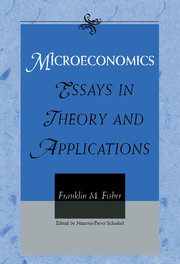Book contents
- Frontmatter
- Contents
- Introduction
- Part I Disequilibrium and Stability
- 1 The Formation of Economic Magnitudes: Disequilibrium and Stability (1990)
- 2 Quasi-Competitive Price Adjustment by Individual Firms: A Preliminary Paper (1970)
- 3 Stability and Competitive Equilibrium in Two Models of Search and Individual Price Adjustment (1973)
- 4 On Price Adjustment without an Auctioneer (1972)
- 5 Quantity Constraints, Spillovers, and the Hahn Process (1978)
- 6 On Stability Analysis with Disequilibrium Awareness (1988)
- 7 It Takes t* to Tango: Trading Coalitions with Fixed Prices (1989)
- 8 An Alternate Proof and Extension of Solow's Theorem on Nonnegative Square Matrices (1962)
- 9 Choice of Units, Column Sums, and Stability in Linear Dynamic Systems with Nonnegative Square Matrices (1965)
- 10 A Simple Proof of the Fisher–Fuller Theorem (1972)
- 11 Gross Substitutes and the Utility Function (1972)
- Part II Welfare Economics and Consumer Theory
- Part III Applications of Microeconomic Theory
- Part IV Industrial Organization, Economics, and the Law
- Part V Public Policy Applications
- Epilogue
- Indexes
3 - Stability and Competitive Equilibrium in Two Models of Search and Individual Price Adjustment (1973)
Published online by Cambridge University Press: 20 March 2010
- Frontmatter
- Contents
- Introduction
- Part I Disequilibrium and Stability
- 1 The Formation of Economic Magnitudes: Disequilibrium and Stability (1990)
- 2 Quasi-Competitive Price Adjustment by Individual Firms: A Preliminary Paper (1970)
- 3 Stability and Competitive Equilibrium in Two Models of Search and Individual Price Adjustment (1973)
- 4 On Price Adjustment without an Auctioneer (1972)
- 5 Quantity Constraints, Spillovers, and the Hahn Process (1978)
- 6 On Stability Analysis with Disequilibrium Awareness (1988)
- 7 It Takes t* to Tango: Trading Coalitions with Fixed Prices (1989)
- 8 An Alternate Proof and Extension of Solow's Theorem on Nonnegative Square Matrices (1962)
- 9 Choice of Units, Column Sums, and Stability in Linear Dynamic Systems with Nonnegative Square Matrices (1965)
- 10 A Simple Proof of the Fisher–Fuller Theorem (1972)
- 11 Gross Substitutes and the Utility Function (1972)
- Part II Welfare Economics and Consumer Theory
- Part III Applications of Microeconomic Theory
- Part IV Industrial Organization, Economics, and the Law
- Part V Public Policy Applications
- Epilogue
- Indexes
Summary
Introduction
The question of how prices change out of equilibrium in a competitive model where all participants take them as given is an important and largely open one in economic theory. In my earlier paper (Fisher, 1970) I presented a model that approached the competitive equilibrium for a single market but in which prices were set by individual firms. That model was extended to one of general equilibrium in Fisher (1972). In both cases firms set prices and customers (with less than perfect information) searched over firms for the most advantageous prices. Firms then adjusted their prices in the direction indicated by the excess demand they encountered, since firms were assumed to believe they were unable to affect the “true” market price that they sought to find.
The trouble with these models, as Rothschild (1973) has forcefully pointed out, is that the assumed behavior of firms may not make much sense. Firms in these models overlook the fact that they are uncertain as to the actual market price, and, more important, they overlook the fact that the imperfection of consumer information gives them a certain amount of market power. A firm that raises its price will not lose all its customers and it cannot escape the attention of high-priced firms that there are customers inquiring as to price who end up going elsewhere. In such a situation, it is not reasonable for firms to behave as though they faced perfectly elastic demand curves, and, while one can argue that if customer search is efficient enough, demand curves will be almost flat, this hardly seems fully satisfactory.
- Type
- Chapter
- Information
- MicroeconomicsEssays in Theory and Applications, pp. 63 - 86Publisher: Cambridge University PressPrint publication year: 1999



